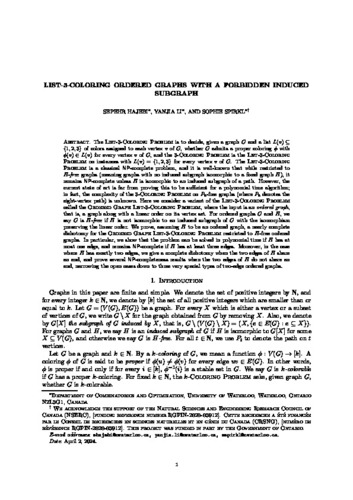| dc.contributor.author | Hajebi, Sepehr | |
| dc.contributor.author | Li, Yanjia | |
| dc.contributor.author | Spirkl, Sophie | |
| dc.date.accessioned | 2024-04-02 15:32:22 (GMT) | |
| dc.date.available | 2024-04-02 15:32:22 (GMT) | |
| dc.date.issued | 2024-03 | |
| dc.identifier.uri | https://doi.org/10.1137/22M1515768 | |
| dc.identifier.uri | http://hdl.handle.net/10012/20413 | |
| dc.description.abstract | Abstract. The List-3-Coloring Problem is to decide, given a graph G and a list L(v) ⊆
{1, 2, 3} of colors assigned to each vertex v of G, whether G admits a proper coloring ϕ with
ϕ(v) ∈ L(v) for every vertex v of G, and the 3-Coloring Problem is the List-3-Coloring
Problem on instances with L(v) = {1, 2, 3} for every vertex v of G. The List-3-Coloring
Problem is a classical NP-complete problem, and it is well-known that while restricted to
H-free graphs (meaning graphs with no induced subgraph isomorphic to a fixed graph H), it
remains NP-complete unless H is isomorphic to an induced subgraph of a path. However, the
current state of art is far from proving this to be sufficient for a polynomial time algorithm;
in fact, the complexity of the 3-Coloring Problem on P8-free graphs (where P8 denotes the
eight-vertex path) is unknown. Here we consider a variant of the List-3-Coloring Problem
called the Ordered Graph List-3-Coloring Problem, where the input is an ordered graph,
that is, a graph along with a linear order on its vertex set. For ordered graphs G and H, we
say G is H-free if H is not isomorphic to an induced subgraph of G with the isomorphism
preserving the linear order. We prove, assuming H to be an ordered graph, a nearly complete
dichotomy for the Ordered Graph List-3-Coloring Problem restricted to H-free ordered
graphs. In particular, we show that the problem can be solved in polynomial time if H has at
most one edge, and remains NP-complete if H has at least three edges. Moreover, in the case
where H has exactly two edges, we give a complete dichotomy when the two edges of H share
an end, and prove several NP-completeness results when the two edges of H do not share an
end, narrowing the open cases down to three very special types of two-edge ordered graphs. | en |
| dc.description.sponsorship | NSERC, RGPIN-2020-03912. | en |
| dc.language.iso | en | en |
| dc.publisher | Society for Industrial and Applied Mathematics | en |
| dc.relation.ispartofseries | SIAM Journal on Discrete Mathematics;38(1) | |
| dc.rights | Attribution 4.0 International | * |
| dc.rights.uri | http://creativecommons.org/licenses/by/4.0/ | * |
| dc.subject | coloring | en |
| dc.subject | list-coloring | en |
| dc.subject | algorithm | en |
| dc.subject | induced subgraph | en |
| dc.subject | ordered graph | en |
| dc.subject | computational complexity | en |
| dc.title | List-3-Coloring Ordered Graphs with a Forbidden Induced Subgraph | en |
| dc.type | Article | en |
| dcterms.bibliographicCitation | Hajebi, S., Li, Y., & Spirkl, S. (2024). List-3-coloring ordered graphs with a forbidden induced subgraph. SIAM Journal on Discrete Mathematics, 38(1), 1158–1190. https://doi.org/10.1137/22m1515768 | en |
| uws.contributor.affiliation1 | Faculty of Mathematics | en |
| uws.contributor.affiliation2 | Combinatorics and Optimization | en |
| uws.typeOfResource | Text | en |
| uws.peerReviewStatus | Reviewed | en |
| uws.scholarLevel | Faculty | en |


